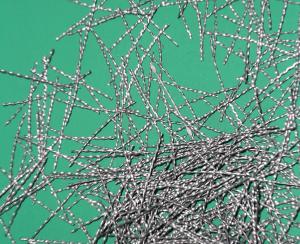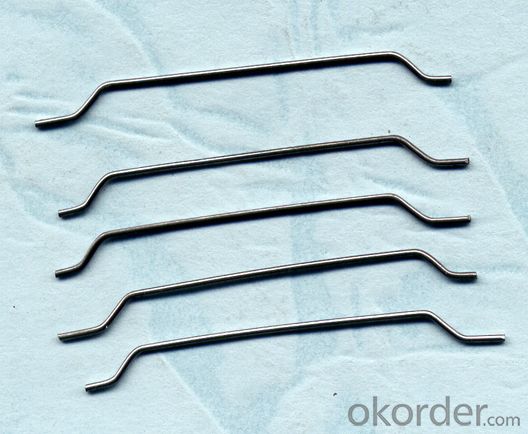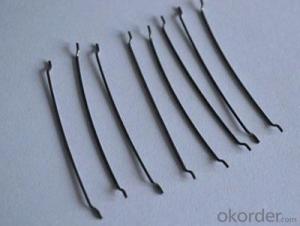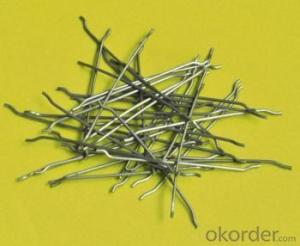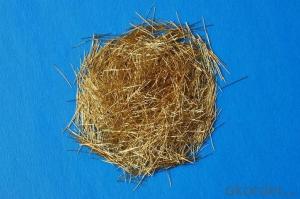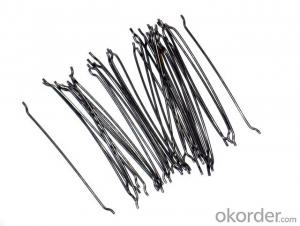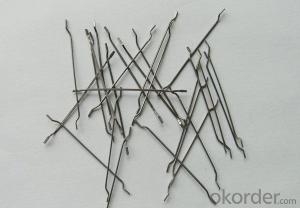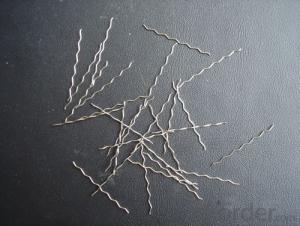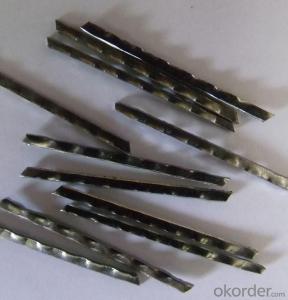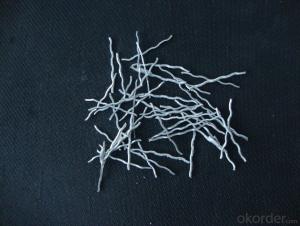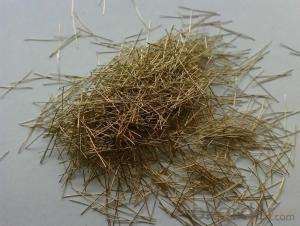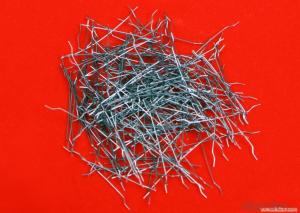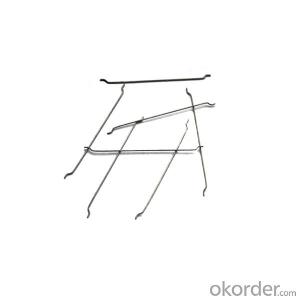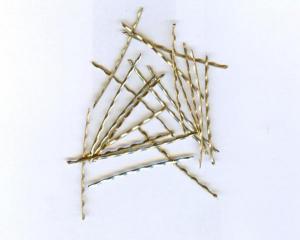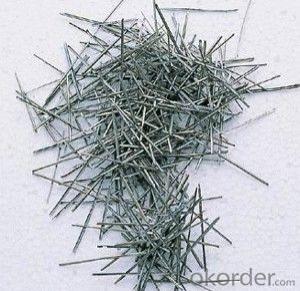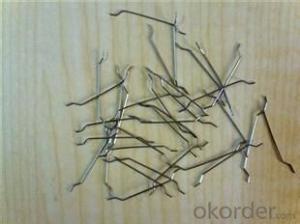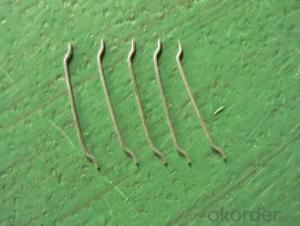Melt Extract Stainless Steel Fiber - Steel Fiber Copper Coated by CNBM International
- Loading Port:
- Tianjin
- Payment Terms:
- TT OR LC
- Min Order Qty:
- 1000 kg
- Supply Capability:
- 30000 kg/month
OKorder Service Pledge
OKorder Financial Service
You Might Also Like
Quick Details
Place of Origin: Jiangsu, China (Mainland)
Model Number: HT-ST
Material: Steel
Specifications
The raw material is stainless steel ingots, using electric stoves which melt the stainless steel ingots to become 1500 ~ 1600 ℃ steel liquid, and then with a grooved high speed rotating melt-extracting steel wheel which produces wires that meets are our customers’ specific requirements. When melting down to a wheel steel liquid surface, the liquid steel blow out by slot with centrifugal force at extremely high speed with cooling forming. Melting wheels with water keep the cooling speed. This method is done to produce different material, different sizes of steel fiber.
| SIZE | CHEMIC ELEMENT(%) | ||||||
| C | P | Mn | Si | Cr | Ni | Al | |
| AISI330 | ≤0.40 | ≤0.04 | ≤2.00 | ≤0.75 | 17~20 | 33~37 | |
| AISI310 | ≤0.40 | ≤0.04 | ≤2.00 | ≤1.50 | 24~26 | 19~22 | |
| AISI316 | ≤0.40 | ≤0.04 | ≤2.00 | ≤1.00 | 16~18 | 10~14 | |
| AISI314 | ≤0.40 | ≤0.045 | ≤2.00 | 1.5-3.0 | 23~26 | 19~22 | |
| AISI309 | ≤0.40 | ≤0.04 | ≤2.00 | ≤1.00 | 22~24 | 12~15 | |
| AISI304 | ≤0.40 | ≤0.04 | ≤2.00 | ≤2.00 | 18~20 | 8~10 | |
| AISI301 | ≤0.40 | ≤0.04 | ≤2.00 | ≤2.00 | 16~18 | 6~8 | |
| AISI201 | ≤0.40 | ≤0.06 | 5.5~7.5 | ≤1.00 | 16~18 | 3.5~5.5 | |
| AISI446 | ≤0.40 | ≤0.04 | ≤1.50 | ≤2.00 | 23~27 | ||
| AISI430 | ≤0.40 | ≤0.03 | ≤1.00 | ≤2.00 | 16~18 | ||
| NAS430A | ≤0.40 | ≤0.03 | ≤0.50 | ≤0.50 | 16~18 | 2~4 | |
| SIZE(mm) | ||||
| length | 20 | 25 | 30 | 35 |
| width | 0.75~1.5 | 0.75~1.5 | 0.75~1.5 | 0.75~1.5 |
| thickness | 0.2~0.75 | 0.2~0.75 | 0.2~0.75 | 0.2~0.75 |
Picture
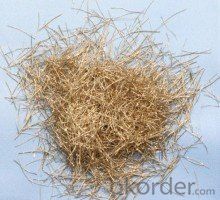
Steel fiber

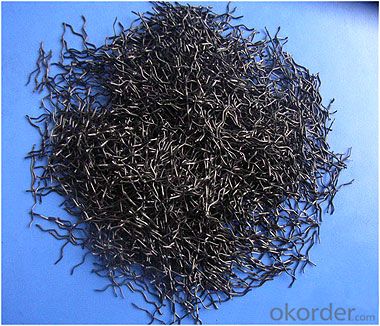
FAQ
certificated: ISO 9001
Technical advantages of Daye steel fiber:
A. Improve mechanical performance of concrete
B. Provide uniform distribution throughout concrete with excellent mixing
C. No balling or caking by adopt correct mixing method
D. Reduce concrete volume
E.Save construction time and cost
F.Reduce excavation volume
G.Available for jointless floor.
- Q: What is a steel fiber cement?
- Fiber concrete is a new kind of multiphase composite material, which is made up of short steel fiber reinforced by random distribution in ordinary concrete. The chaos to the distribution of steel fiber can be formed effectively hinder the propagation of concrete internal micro cracks and macro cracks, improve concrete tensile strength, bending strength, impact resistance and fatigue performance, has good ductility.
- Q: Is melt extract stainless steel fiber compatible with all types of concrete surface finishes?
- Melt extract stainless steel fiber is compatible with most types of concrete surface finishes. However, it is important to note that the compatibility may vary depending on factors such as the specific type of concrete surface finish, the application method, and the desired outcome. In general, melt extract stainless steel fiber can be successfully used with various types of concrete surface finishes, including smooth finishes, exposed aggregate finishes, stamped finishes, and textured finishes. The fibers can enhance the durability, strength, and crack resistance of the concrete, making it suitable for a wide range of applications. However, it is recommended to consult with a concrete expert or manufacturer to ensure the compatibility of melt extract stainless steel fiber with a specific type of concrete surface finish. They can provide valuable insights and guidance on the optimal fiber dosage, mixing methods, and application techniques to achieve the desired results. Additionally, they can also help address any potential concerns or limitations related to the compatibility of the fiber with the chosen surface finish.
- Q: What are the advantages of using melt extract stainless steel fiber in shotcrete applications?
- Using melt extract stainless steel fiber in shotcrete applications offers several advantages: 1. Enhanced durability: Stainless steel fibers have excellent corrosion resistance, making them ideal for shotcrete applications in harsh environments or structures exposed to moisture, chemicals, or high temperatures. This durability ensures the longevity and structural integrity of the shotcrete. 2. Improved crack resistance: Stainless steel fibers enhance the crack resistance and toughness of shotcrete. They distribute stress more evenly throughout the material, reducing the likelihood of cracks forming and propagating. This helps to prevent water infiltration, reinforcing the shotcrete and increasing its overall strength. 3. Increased flexural strength: The addition of stainless steel fibers in shotcrete improves its flexural strength. This reinforcement allows for greater resistance to bending or deflection, making the shotcrete more resilient under various loads or structural movements. 4. Enhanced impact resistance: Stainless steel fibers enhance the impact resistance of shotcrete, making it more resistant to external forces such as impact or vibrations. This advantage is particularly beneficial in shotcrete applications where structures may be exposed to heavy traffic, seismic activity, or significant dynamic loads. 5. Ease of application: Melt extract stainless steel fibers are easily incorporated into shotcrete mixtures, as they can be uniformly distributed throughout the material during the mixing process. This ease of application contributes to time and cost savings during construction. Overall, using melt extract stainless steel fiber in shotcrete applications provides numerous advantages, including enhanced durability, improved crack resistance, increased flexural strength, enhanced impact resistance, and ease of application.
- Q: What is the effect of melt extract stainless steel fiber on the abrasion resistance of concrete?
- The addition of melt extract stainless steel fiber to concrete has a significant positive effect on its abrasion resistance. Stainless steel fibers are known for their high tensile strength, corrosion resistance, and durability. When incorporated into concrete, these fibers provide reinforcement and enhance its overall mechanical properties. The melt extract process ensures that the stainless steel fibers are produced with a consistent diameter and length, resulting in improved dispersion throughout the concrete matrix. This even distribution of fibers helps to create a three-dimensional reinforcement network, which effectively increases the concrete's resistance to abrasion. The presence of stainless steel fibers in concrete enhances its ability to withstand wear and tear caused by frictional forces. This is especially beneficial in high traffic areas, such as industrial floors, parking lots, and roadways, where the concrete is subjected to heavy loads, vehicle movement, and continuous foot traffic. Stainless steel fibers also improve the impact resistance of concrete, reducing the likelihood of surface spalling or cracking due to external forces. This added durability leads to reduced maintenance and repair costs over the lifespan of the concrete structure. In summary, the incorporation of melt extract stainless steel fiber in concrete significantly enhances its abrasion resistance. It improves the concrete's ability to withstand wear and tear caused by frictional forces, extends its lifespan, and reduces the need for frequent maintenance and repair.
- Q: Can melt extract stainless steel fiber be used in thin concrete overlays?
- Thin concrete overlays can make use of melt extract stainless steel fiber. These fibers are commonly incorporated into concrete mixes to enhance their mechanical properties and bolster their durability. In the case of thin concrete overlays, where the concrete layer is less than 2 inches thick, the inclusion of stainless steel fibers can aid in reducing cracks and increasing resistance to shrinkage and impact. The fibers offer additional reinforcement and enhance the overall performance of the concrete overlay. However, it is imperative to ensure the correct dosage and even distribution of fibers throughout the mix for optimal outcomes. Furthermore, proper surface preparation and application techniques are vital for the successful utilization of melt extract stainless steel fiber in thin concrete overlays.
- Q: What is the effect of melt extract stainless steel fiber on the crack width in shotcrete?
- The use of melt extract stainless steel fiber in shotcrete has a significant effect on the crack width in the material. Stainless steel fibers are known for their high tensile strength and durability, making them an ideal reinforcement material for shotcrete applications. When added to the shotcrete mix, the stainless steel fibers are uniformly distributed throughout the material, creating a network of reinforcement that enhances its structural integrity. This reinforcement helps to reduce the crack width in the shotcrete, as the fibers effectively bridge the cracks and prevent their propagation. The melt extract stainless steel fibers act as micro-reinforcement within the shotcrete, increasing its ductility and resistance to cracking. This is particularly beneficial in areas with high stress concentrations or where cracking is a common issue, such as in tunnels, underground structures, or retaining walls. By reducing the crack width in shotcrete, the use of melt extract stainless steel fibers improves the overall durability and longevity of the material. It enhances its resistance to environmental factors, such as freeze-thaw cycles, chemical exposure, or mechanical loading, which can lead to crack propagation and subsequent deterioration. Furthermore, the reduced crack width in shotcrete also improves its aesthetic appearance, as it minimizes the visible signs of cracking on the surface. This is particularly important in architectural applications where the shotcrete is left exposed and serves as a decorative element. In summary, the addition of melt extract stainless steel fibers to shotcrete has a positive effect on the crack width in the material. It improves its structural integrity, durability, resistance to cracking, and overall aesthetic appearance, making it a valuable reinforcement option for shotcrete applications.
- Q: How does melt extract stainless steel fiber affect the curing time of concrete?
- Melt extract stainless steel fiber can potentially reduce the curing time of concrete. The addition of these fibers improves the overall strength and durability of the concrete by enhancing its crack resistance and reducing shrinkage. As a result, the concrete cures faster and achieves its desired strength more quickly.
- Q: Can melt extract stainless steel fiber be used in wastewater treatment plant construction?
- Yes, melt extract stainless steel fiber can be used in wastewater treatment plant construction. Stainless steel fibers are commonly used in construction materials for their high strength, durability, and resistance to corrosion. In wastewater treatment plants, where there is constant exposure to moisture and chemicals, the use of stainless steel fibers can enhance the performance and longevity of the construction materials. These fibers can be incorporated into concrete, cement, or other composite materials to improve their mechanical properties and increase their resistance to cracking, spalling, and deterioration. Additionally, stainless steel fibers can also help to reduce the formation of cracks and enhance the overall structural integrity of the construction elements. Therefore, the use of melt extract stainless steel fibers can be a viable option for wastewater treatment plant construction.
- Q: What is the effect of melt extract stainless steel fiber on the modulus of rupture of concrete?
- The effect of melt extract stainless steel fiber on the modulus of rupture of concrete is an increase in strength and resistance to cracking. The fibers reinforce the concrete matrix, providing enhanced tensile strength and improving the overall durability and structural integrity of the concrete.
- Q: What is the impact of melt extract stainless steel fiber on the shrinkage of concrete?
- The impact of melt extract stainless steel fiber on the shrinkage of concrete is that it helps to reduce or mitigate the shrinkage cracks that can occur during the curing and drying process of concrete. The steel fibers provide reinforcement and improve the overall strength and durability of the concrete, thereby reducing the potential for shrinkage and cracking.
Send your message to us
Melt Extract Stainless Steel Fiber - Steel Fiber Copper Coated by CNBM International
- Loading Port:
- Tianjin
- Payment Terms:
- TT OR LC
- Min Order Qty:
- 1000 kg
- Supply Capability:
- 30000 kg/month
OKorder Service Pledge
OKorder Financial Service
Similar products
Hot products
Hot Searches
Related keywords
